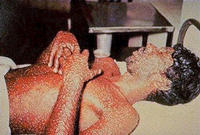-
Cesium chloride blood irradiators increase dirty bomb risk
Federal officials want to halt the use of blood irradiators used by hospitals and blood centers to ensure that blood is properly treated before transfusions occur. The irradiation devices contain cesium chloride, a highly radioactive powder which terrorists could use to make a dirty bomb. A 2008 reportby the National Academy of Sciences recommended stopping the licensing of new cesium chloride radiation sources, thereby encouraging the adoption of alternative sources with a less dispersible form of radioactive cesium, including cobalt-60 or X-ray irradiators.
-
-
Converting light to sound for better weapons detection, medical imaging
A device that essentially listens for light waves could help open up the last frontier of the electromagnetic spectrum — the terahertz range. So-called T-rays, which are light waves too long for human eyes to see, could help airport security guards find chemical and other weapons. They might let doctors image body tissues with less damage to healthy areas. They could also give astronomers new tools to study planets in other solar systems. Those are just a few possible applications.
-
-
Border Collies chase away beach contamination
Gull droppings may be one source of the indicator bacterium Escherichia coli to beach water, which can lead to swim advisories and beach closings. Border Collies are effective at reducing gull congregation on recreational beaches, resulting in lower E. coli abundance in the sand.
-
-
Bill would encourage development of drugs to treat antibiotic-resistant bacteria
The U.S. Centers for Disease Control and Prevention(CDC) reported that two million Americans are infected by antibiotic-resistant pathogens every year, and the pathogens cause 23,000 deaths annually. In 1990, about twenty pharmaceutical companies had large antibiotic research and development programs, but today only three large firms and a few small companies are investing in antibiotic research. A new proposed bill, the Developing an Innovative Strategy for Antimicrobial Resistant Microorganisms Act, would encourage pharmaceutical companies to develop new drugs to treat antibiotic-resistant bacteria.
-
-
Absorbent used in kitty litter may be cause of radiation leaks in U.S. nuke dump
A wheat-based absorbent often used in kitty litter may be the likely cause of the radiation leak that led to the closure of the Waste Isolation Pilot Plant(WIPP), the U.S. only underground nuclear waste repository, according to Jim Conca, a former geochemist at Los Alamos National Laboratory(LANL). Conca noted that EnergySolutions, a Salt Lake City-based company hired to package radioactive waste at LANL into containers for shipment to the WIPP, switched from using a clay-based absorbent in the storage drums to a wheat-based mixture.
-
-
Pandemics: who should be given life-saving treatment first? Who should make the decision?
In the event of a flu pandemic, who should have priority access to life-saving ventilators, and who should make that determination? Few disaster preparedness plans have taken community values regarding allocation into account, but a new study is aiming to change that through public engagement with Maryland residents. “In the event of a healthcare crisis, understanding the community perspective and having citizen buy-in will be critical to avoid compounding the initial disaster with further social upheaval,” says the principal investigator.
-
-
Better understanding of the 1918 Flu Pandemic aids in better infectious disease response today
The 1918 Flu Pandemic infected over 500 million people, killing at least fifty million. Now, researchers have analyzed the pandemic in two remote regions of North America, finding that despite their geographical divide, both regions had environmental, nutritional, and economic factors that influenced morbidity during the pandemic. Findings from the research could help improve current health policies.
-
-
New biodefense centers offer modernized approach, face criticism
A new facility at Texas A&M University is one of three new biodefense centers created by the U.S. Department of Health and Human Services (HHS) to revolutionize the way fatal viruses are countered in the event of an emergency. The $286-million lab features mobile clean rooms that can be detached and moved to form different production or testing systems as the need arises. Not everyone agrees that the design and capabilities of the new center would offer the best response to biothreats.
-
-
Debate intensifies over whether or not to destroy last stockpile of smallpox

The world’s health ministers are scheduled to meet later this month to discuss the fate of the last known stockpiles of smallpox, held under tight security in two labs— one in the United States and the other in Russia. Smallpox has been eradicated for more than three decades, but some U.S. health officials say the remaining stockpiles should be kept for further studies. The smallpox virus is being used to develop drugs and safer vaccines in case the virus returns through terrorism or a lab accident. Member nations of the World Health Organization (WHO) once agreed that the last virus strains known to officials would eventually be destroyed, but a set date was never agreed upon.
-
-
California bill banning use of antibiotics in livestock withdrawn

The Centers for Disease Control and Preventionreports that 23,000 people die every year from infections that cannot be cured, often due to overuse of antibiotics which creates drug resistant bugs. Last Wednesday, California Assemblyman Kevin Mullin (D-San Mateo) withdrew proposed legislation which would ban the sale of meat and poultry fed on nontherapeutic antibiotics. He lacked sufficient support from fellow legislators.
-
-
New technology to detect previously undetectable fecal contamination in water
Technology capable of sampling water systems to find indicators of fecal matter contamination that are thousandths and even millionths of times smaller than those found by conventional methods is being developed by researchers. The researchers have developed an ultrasensitive detection method that can detect molecules associated with human and animal fecal matter in water systems. These extremely small indicators, he explains, have been traditionally difficult to detect but can signal greater levels of contamination, which can lead to illness and even death.
-
-
Promising agents breach superbug defenses to fight antibiotic resistance
In the fight against “superbugs,” scientists have discovered a class of agents that can make some of the most notorious strains vulnerable to the same antibiotics that they once handily shrugged off. Scientists have been developing new agents to combat these enzymes, but the agents so far have fallen short. A new class of agents, called metallopolymers, shows promise.
-
-
New bug sensor saves crops, people

For hundreds of years humans have attempted to kill unwanted insects. While some blanket methods have been successful, they can be costly and create environmental problems. A new sensor developed by UC Riverside researchers aims to change that by counting and classifying the insects so that the substance used to eradicate the harmful insects can be applied on a precision targeted level. The inexpensive wireless sensors have 99 percent accuracy, and they are expected to have applications fighting insect-borne diseases, such as malaria, and insects that damage crops.
-
-
1918 pandemic flu virus mystery solved

Just as the world was recovering from the devastation of the First World War, another killer swept across the globe. A deadly flu virus attacked more than one-third of the world’s population, and within months had killed more than fifty million people — three times as many as the war — and had done it more quickly than any other illness in recorded history. Until now, the origin of the 1918 pandemic flu virus and its unusual severity have vexed health experts. A new study not only sheds light on the devastating 1918 pandemic, but could also improve vaccination strategies, and pandemic prevention and preparedness.
-
-
First large-scale dengue vaccine efficacy study achieves primary clinical goals
Dengue is a threat to nearly half the world’s population, and is a pressing public health priority in many countries in Asia and Latin America where epidemics occur. Sanofi Pasteur, the vaccines division of Sanofi, yesterday announced that the first of two pivotal Phase III efficacy studies with its dengue vaccine candidate has achieved its primary clinical endpoint. The efficacy study showed a significant reduction of 56 percent of dengue disease cases. The study involved more than 10,000 volunteers from Asia.
-